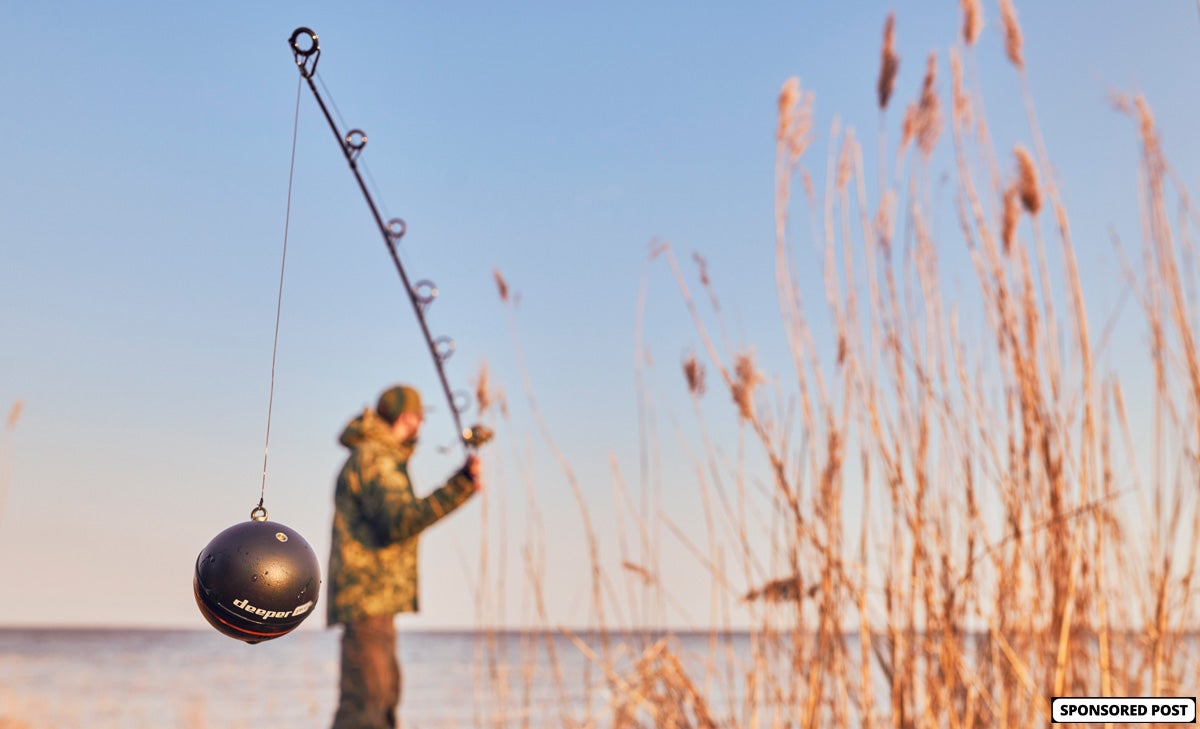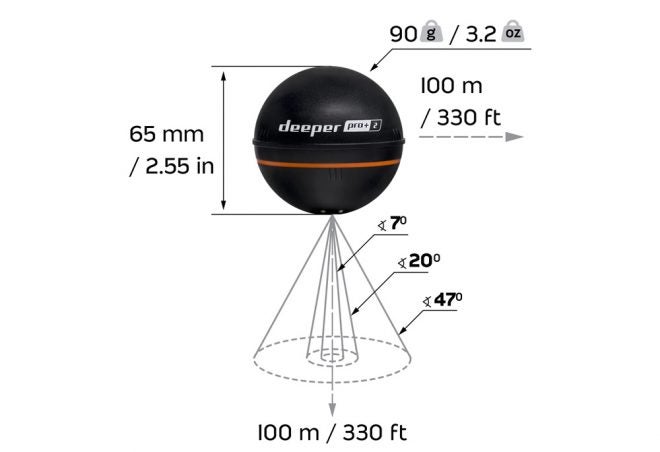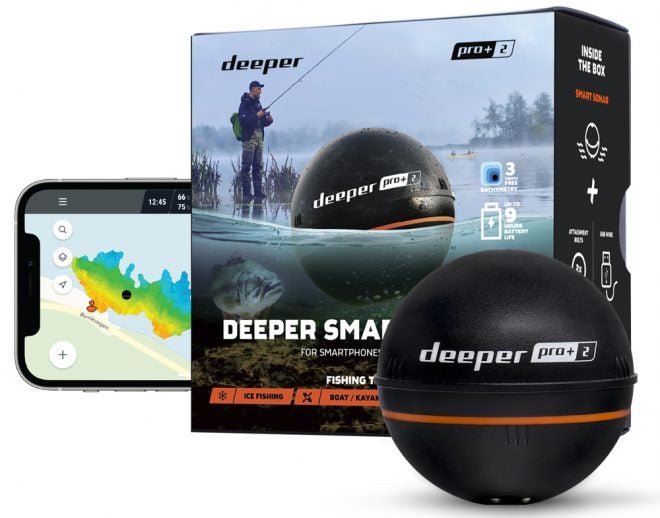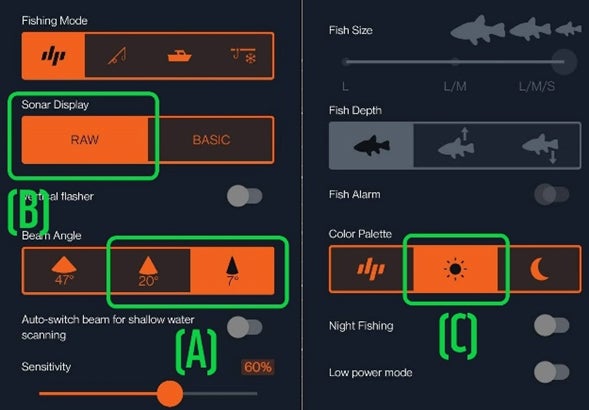The Deeper PRO+ 2 is the Castable Smart Sonar You’ve Been Waiting For
Sponsored Content 05.24.22

Eons ago, man fished with spears. Our ancestors, equipped with nothing but a pointy stick, keen eyesight, and wicked-fast reflexes, would remain perfectly still for minutes at a time, waiting for a sufficiently meaty fish to swim within range and, with all the explosiveness of a cheetah, promptly run it through.
Centuries passed, new technologies arose, and man eventually realized it might in fact be far easier to fish with a pole. Point being: we aren’t living in the stone ages any more, and the angler who doesn’t use every modern tool at their disposal isn’t fishing up to their potential. And far and away one of the niftiest and most useful angler tools to come along in the past several years is the castable sonar.
Fish finders have been around for quite a long while; the first came along all the way back in the late 1940s, originating in Japan. But if there are two common themes among most fish finder units, it’s that they tend to be quite expensive, and they’re not especially portable. That’s changed within the last decade or so, with the advent of handheld and castable fish finders, and the Deeper Smart Sonar PRO+ 2 castable fish finder might represent something of a “sweet spot” in the market – a perfect balance between performance and price.
What’s New
The Deeper PRO+ 2 occupies a similar place in the market to the less-expensive Deeper PRO+, but looking at the specs, it’s a significantly different animal. Compared to the PRO+, the PRO+ 2 weighs 10 grams less at 90 grams. That’s not a drastic difference, but when we’re talking about something you’re going to be casting from your rod throughout the day, every little bit counts. More critically, the PRO+ 2 actually features a bigger battery (950 mAh vs. 850 mAh for the PRO+) giving you up to 9 hours of operating time, depending on usage.
In addition, compared to its predecessor, the PRO+ 2 boasts an increased scanning depth, reaching as deep as 330 feet (100 meters) compared to the PRO+’s 260-foot (80-meter) maximum scan depth. But probably the biggest leg up is in the available sonar scan frequencies/beam angles. The Deeper PRO+ 2 offers three beam angles instead of just two: 47° (100 kHz), 20° (240 kHz), and 7° (675 kHz). The super-narrow 7-degree beam lets you really zero in on your mark once you’ve found it, and the 20-degree is a bit more usable than the PRO+’s compromise 15-degree tight beam. The PRO+ offers a bit more broad-area scanning range, with a maximum beam angle of 55°, but how much that extra 8° really matters is up for debate. In our opinion, you’re probably not going to miss it.
What Hasn’t Changed
Like the PRO+, the Deeper PRO+ 2 connects to your smartphone remotely through WiFi instead of Bluetooth. WiFi in this case is not internet, but rather a connection between two devices. No internet connection is needed for the sonar to work. And WiFi is a very good thing; it means that the PRO+ 2 is able to offer the same impressive 330-foot broadcast range as the PRO+, and as WiFi data transmission can be up to 10 times faster than Bluetooth, you get super smooth trolling, with data updated in real time.
The Fish Deeper mobile phone/tablet app is still a thing of beauty, too, with remarkably clear, detailed displays so you can make out every contour and bit of vegetation, every structure, and every fish. You can even mark your favorite boat launches, camping sites, and other points of interest directly in the app, and use it to log catches with photos and helpful notes like what lure or bait you were using, and what techniques. A free 3-month subscription to Fish Deeper Premium, included with every PRO+ 2 purchase, enhances the app even further with access to detailed bathymetric depth maps for over 50,000 fishing spots.
What It’s Good For
It’s hard to think of a scenario that the Deeper PRO+ 2 wouldn’t be good for. It’s so small and light that it’s easy to bring with you just about anywhere, and if it ever runs out of juice, it recharges fast from a laptop or portable battery bank.
But that small size and light weight make the PRO+ 2 especially well-suited to freshwater fishing from the shore, in a kayak, or in another small boat like an inflatable. For watercraft it is perfect when used together with Flexible Arm 2.0. Just stuff it into your pack or dry bag, along with your cellphone, and it’s right there when you need it – no extra bulk or loose gizmos to carry around. It delivers far better performance and visual clarity than your average handheld fish finder, and we especially like that we can keep catch notes and use the PRO+ 2 to create bathymetric maps from the boat with the Fish Deeper mobile app. As angling is as much a science as it is an art, being able to archive and recall data about where we’ve been and where we’ve had success in the past is valuable.
And the Deeper PRO+ 2 is even perfect for ice fishing. It’s rated for temperatures as cold as -4°F (-20°C), and it has enough battery capacity to deliver a usable amount of operating time even in those frigid temps. Of course, lithium-polymer batteries will always have some issues maintaining charge in the cold, but you can still get a lot of life out of the PRO+ 2 by turning off scanning when you don’t need it and tucking it away in your pocket so it stays warm.
Tips & Tricks
A couple could be given:
- Fish Icons vs Fish Arches
Fish icons are fun when you start using Deeper sonar. After getting better at reading sonar, anglers realize there is a whole world of information hiding beneath these icons. Let’s switch them off and check out the arches – raw sonar readings which represent fish.
- a) Full arches appear if fish move through the full sonar cone.
b) Half-arches or thick dashes appear if fish move partially through the cone.
c) If your sonar and fish are both stationary, you will see a straight line.
- Bottom Hardness
One of the most frequently asked questions we receive is how determine whether the scanned bottom is hard or soft. ?? First, for best results we recommend these settings: Narrow or Mid-angle Beam (A), Raw Sonar Display (B) and Day Color Palette (C).
There are 3 factors that can help determine if the bottom is hard or soft:
- a) Color. Using Day color palette, hard bottom will always be shown in bright yellow color. Soft bottom will consist of darker colors, you will see more blue and red.
b) Thickness. The thickness of the line representing the bottom is also an indicator of the bottom hardness, the thicker the line, the harder the bottom.
c) Second sonar return. Sometimes you might see a second bottom line displayed below the bottom line. It is called a second sonar return, which is an indication of a very hard bottom. If you see one, it usually suggests the bottom consists of gravel, pebbles, cobbles or boulders.
- Using the correct Attachment Bolt Position
Bottom attachment hole – for casting from shore (rod tip is at same level as water)
Middle attachment hole:
- For casting from high pier or cliff (rod tip is higher than water level)
- For securing the screw of Flex arm 2.0 (when using with watercraft)
Top attachment hole – for attaching safety strap when using with Flex arm 2.0 on watercraft or when ice fishing.
Deeper PRO+ 2: The Bottom Line
We love the Deeper PRO+ 2. Deeper’s castable sonar units have always been among our absolute favorite portable fish finders, owing mostly to their performance and ease-of-use, and the PRO+ 2 has emerged as a new sweet spot in the lineup. It packs much of the same performance you get with the more expensive CHIRP 2, but at a lower price point, and it’s demonstrably better than the regular PRO+.
We may have just found our new favorite castable fish finder.
Click here to learn more about the Deeper Smart Sonar PRO+ 2 or shop on Amazon.



